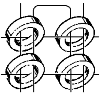2.2.2000 News from the LGP-30
("No. 4 lives")
Highspeed papertape reader
Further analysis of the fault caused by the papertape reader revealed: The only instruction that really worked was the I instruction, in other words the input from the papertape reader. All other instructions of a program either appeared in the instruction register not at all or shifted by several bits. We concluded that this wasn't a corrupt transmission but some sort of handshaking problem, this one being static because the fault also appeared when the reader was idle.
The 'handshake' during input of the LGP-30 is very rudimentary: the I (input) instruction causes the computer to halt. Each character from the device is shifted into the right of the accumulator with an external clock. If the input device reads a stop code ' the computer is started again in order to process the characters in the accumulator.
It was now obvious that the problem must have to do with the timing or clock of the external device in conjunction with the instruction fetch mechanism.
There is only one I instruction in the instruction set of the LGP-30 that handles input for both the Friden Flexowriter and the highspeed reader. The differentiation between the two devices is done with a big rotary switch. This switch changes the two 6 bit data channels (normal and complementary) and the three clock lines.
By comparing the levels of the clock lines we found one that, when attaching the highspeed reader, had a somewhat higher potential (0.5V instead of 0.1V). Shorting the line to ground made the fault disappear. Changing the clamping diode at the output of the driver in the papertape reader was successful: the reader was working again.
Note for technicians:
The tubes in the LGP-30, with one exception, are supplied with two voltages:
+150V wrt. ground (anode voltage) and -160V wrt. ground (cathode voltage).
Clamping diodes at the outputs of the flip-flops, inverters and cathode
followers are used to limit the voltages between ca. 0V (ground potential) and
-20V (at the logic board) respectively -50V. Exactly one of these diodes had a
forward drop that was too high causing the fault.
